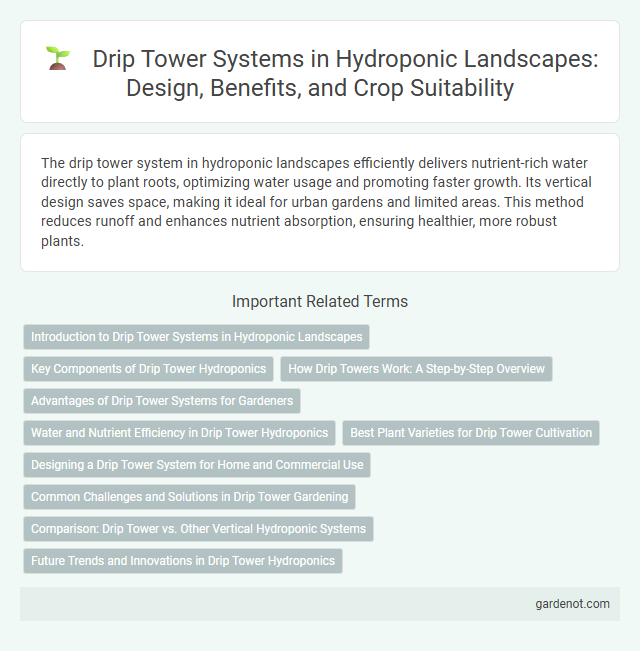The drip tower system in hydroponic landscapes efficiently delivers nutrient-rich water directly to plant roots, optimizing water usage and promoting faster growth. Its vertical design saves space, making it ideal for urban gardens and limited areas. This method reduces runoff and enhances nutrient absorption, ensuring healthier, more robust plants.
Introduction to Drip Tower Systems in Hydroponic Landscapes
Drip tower systems in hydroponic landscapes utilize vertical structures where nutrient-rich water is delivered directly to plant roots via controlled drip emitters, maximizing space efficiency and water use. These systems enhance plant growth by providing a consistent flow of oxygenated nutrient solution, reducing disease risk through minimal substrate saturation. Implementing drip tower hydroponics allows for scalable, soil-free cultivation with precise control over nutrient delivery and environmental conditions.
Key Components of Drip Tower Hydroponics
Drip tower hydroponics relies on key components such as the vertical tower structure, drip emitters, and a nutrient reservoir. The vertical tower maximizes space efficiency by allowing multiple plant sites to receive nutrients simultaneously. Drip emitters regulate the flow of nutrient solutions to plant roots, ensuring precise hydration and nutrient delivery for optimal growth.
How Drip Towers Work: A Step-by-Step Overview
Drip towers operate by circulating nutrient-rich water from a reservoir to the top of the tower, where it drips down through multiple growing layers, delivering essential nutrients directly to plant roots. Each level in the tower is designed to maximize exposure to the water solution, ensuring efficient absorption and optimal growth in a compact vertical space. A pump continuously recycles the water, maintaining a consistent flow that supports sustained plant hydration and nutrient uptake in hydroponic landscapes.
Advantages of Drip Tower Systems for Gardeners
Drip tower systems offer gardeners efficient water usage by delivering nutrients directly to plant roots, reducing wastage and promoting faster growth. Their vertical design maximizes space, allowing cultivation of a variety of crops in limited areas, ideal for urban and indoor gardens. These systems also minimize soil-borne diseases by maintaining a soilless environment, enhancing plant health and yield.
Water and Nutrient Efficiency in Drip Tower Hydroponics
The drip tower hydroponic system maximizes water and nutrient efficiency by delivering a controlled, steady flow of nutrient solution directly to plant roots, minimizing waste and runoff. This vertical design allows for precise drip irrigation, ensuring optimal absorption and reducing excess water usage by up to 40% compared to traditional methods. Enhanced nutrient recirculation within the tower further improves plant uptake, promoting sustainable growth with lower environmental impact.
Best Plant Varieties for Drip Tower Cultivation
Leafy greens like lettuce, spinach, and kale thrive in drip tower systems due to their fast growth and shallow root structures. Herbs such as basil, mint, and cilantro are ideal for drip tower cultivation because they require consistent moisture and good aeration. Fruit-bearing plants like strawberries and cherry tomatoes also perform well, benefiting from the efficient nutrient delivery and controlled environment of drip towers.
Designing a Drip Tower System for Home and Commercial Use
Designing a drip tower system for hydroponic landscapes involves selecting vertical modular towers to maximize plant density and optimize water circulation. Incorporating adjustable drip emitters ensures precise nutrient delivery tailored to various crop requirements while reducing water waste. Integrating a recirculating reservoir with timed pumps enhances system efficiency, making it suitable for both home and commercial applications.
Common Challenges and Solutions in Drip Tower Gardening
Drip tower gardening often faces challenges such as clogging of drip emitters caused by nutrient solution buildup or debris, which disrupts water flow and plant hydration. Ensuring regular maintenance by flushing the system with filtered water and using quality nutrient solutions can prevent blockages and maintain optimal plant growth. Monitoring pump pressure and adjusting drip rates accordingly helps address uneven water distribution and supports consistent nutrient delivery.
Comparison: Drip Tower vs. Other Vertical Hydroponic Systems
Drip towers offer a distinct advantage in vertical hydroponic systems by providing precise nutrient delivery through controlled dripping, which minimizes water waste compared to nutrient film technique (NFT) systems. Unlike aeroponics that rely on misting roots, drip towers ensure consistent moisture levels and reduce root disease risks due to better oxygenation and drainage. Their modular design also allows easier scalability and maintenance compared to stacked or tower systems that may suffer from uneven nutrient distribution and clogs.
Future Trends and Innovations in Drip Tower Hydroponics
Emerging innovations in drip tower hydroponics emphasize automated nutrient delivery systems integrated with IoT sensors for real-time monitoring of plant health and growth conditions. Future trends include the development of sustainable materials for drip tower construction, enhancing durability while reducing environmental impact. Enhanced AI-driven algorithms optimize water and nutrient usage, promoting higher crop yields and resource efficiency in urban agriculture settings.
Drip tower Infographic

 gardenot.com
gardenot.com